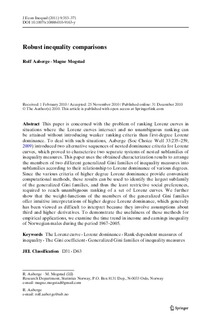| dc.contributor.author | Aaberge, Rolf | |
| dc.contributor.author | Mogstad, Magne | |
| dc.date.accessioned | 2012-02-27T19:45:50Z | |
| dc.date.available | 2012-02-27T19:45:50Z | |
| dc.date.issued | 2011 | |
| dc.identifier.citation | Journal of Economic Inequality, 2011, Volume 9, Number 3, Pages 353-371 | no_NO |
| dc.identifier.issn | 1573-8701 | |
| dc.identifier.issn | | |
| dc.identifier.uri | http://hdl.handle.net/11250/178076 | |
| dc.description | © The Author(s) 2010. This article is published with open access at Springerlink.com | no_NO |
| dc.description.abstract | This paper is concerned with the problem of ranking Lorenz curves in situations where the Lorenz curves intersect and no unambiguous ranking can be attained without introducing weaker ranking criteria than first-degree Lorenz dominance. To deal with such situations, Aaberge (Soc Choice Welf 33:235–259, 2009) introduced two alternative sequences of nested dominance criteria for Lorenz curves, which proved to characterize two separate systems of nested subfamilies of inequality measures. This paper uses the obtained characterization results to arrange the members of two different generalized Gini families of inequality measures into subfamilies according to their relationship to Lorenz dominance of various degrees. Since the various criteria of higher degree Lorenz dominance provide convenient computational methods, these results can be used to identify the largest subfamily of the generalized Gini families, and thus the least restrictive social preferences, required to reach unambiguous ranking of a set of Lorenz curves. We further show that the weight-functions of the members of the generalized Gini families offer intuitive interpretations of higher degree Lorenz dominance, which generally has been viewed as difficult to interpret because they involve assumptions about third and higher derivatives. To demonstrate the usefulness of these methods for empirical applications, we examine the time trend in income and earnings inequality of Norwegian males during the period 1967–2005. Keywords The Lorenz curve – Lorenz dominance – Rank-dependent measures of inequality – The Gini coefficient – Generalized Gini families of inequality measures
JEL Classification D31 – D63 | no_NO |
| dc.language.iso | eng | no_NO |
| dc.publisher | Springer | no_NO |
| dc.relation.uri | http://www.springerlink.com/content/d72g6l62339p3468/ | |
| dc.subject | Lorenz curve | no_NO |
| dc.subject | Lorenz dominance | no_NO |
| dc.subject | Measures of inequality | no_NO |
| dc.subject | Gini coefficient | no_NO |
| dc.subject | Inequality measures | no_NO |
| dc.subject | Scientific article | |
| dc.title | Robust inequality comparisons | no_NO |
| dc.type | Journal article | no_NO |
| dc.type | Peer reviewed | no_NO |
| dc.subject.nsi | VDP::Social science: 200::Economics: 210::Economics: 212 | no_NO |
| dc.source.pagenumber | 353-371 | no_NO |
| dc.source.volume | Volume 9 | no_NO |
| dc.source.journal | Journal of Economic Inequality | no_NO |
| dc.source.issue | Number 3 | no_NO |
